#buy kitsch instead
Explore tagged Tumblr posts
Note
Outside of animatronics, do you have any other niche interests?
depends what you qualify as niche tbh lol . my other big fixation rn is fallout new vegas ofc, which i dont rly think counts as niche unless you arent really a video games person. my other main video game related interest is shovel knight which is Also kinda a famous game but its way more niche than fallout at least lol. it's been like 6 years and you can still get me to write you an essay about specter knight at any time
i also have a lot of interest and passion in specific music artists/genres but i dont rly talk abt that online for some reason?? i feel like it's harder to discuss an audio only format that well online lol. my music taste is fairly eclectic but if u ever wanna talk music ask me about numetal or classic country or classic rock. or hyperpop. or most other genres but those are my current favs lol
and i guess as far as like, really specific things go- i dont rly consider these Interests as much as like. Hobbies i guess lol but me and packtion are always trying out some new thing together. we dip into linguistics and trying to learn languages often (which rarely goes far lol), occasionally technology in general (though thats slightly more their thing), and them being a musician has def contributed to my appreciation for ability to talk abt music lol. most recently we've started learning gregg notehand, which is a form of shorthand (packtion had previously tried out stenography) and it's made my notebook which i usually draw in look insane lmao


#asks#i honestly consider all my animatronic and travel related interests as like. many smaller interests under a big umbrella#like im rly interested in rainforest cafe but there isnt much overlap between rae/cec and rfc fans#so i just think of it as a different but similar thing#which is how ive been able to branch out into other themed entertainment stuff that doesnt always have animatronics#without me feeling too off brand lmao#ive just come to love kitsch and americana and stuff in general#ive been to a buc-ee's once and it was equal parts entertaining and kinda horrifying. theres so much shit w that beavers face on it#but i did buy a plushie. and take a picture with him. and it was great#im super interested in mars 2112 which doesnt have animatronics but is otherwise just rfc in space lmao#more on that in a future video probably#a year or so ago i went to the world's largest buffet which is in pennsylvania. just for the kitsch#its called shady maple smorgasbord. frankly i think the buffet was kinda mid. and i think the title is kinda unearned#the buffet itself isnt rly much bigger than like. a golden corral. but the building itself is HUGE#so like Technically its the largest buffet but . whatever lol#it makes up for it w the entire basement (also huge) being a gift shop. and also they had these like. 3d paintings which were sick#ive got videos if anyones curious. and i bought a shirt bc ofc i did lmao#i wear it in my upcoming video and if i couldve talked abt shady maple in it i wouldve lol#but instead my review lives in these tumblr tags
2 notes
·
View notes
Text
A new migrant's perspective on how Tumblr works
So, basically, how Tumblr works is this:
We are all, all of us, in a series of caves. Some of the inhabitants of the caves have dug little holes or access routes to the surface, where strange things like blue tweeting birds dwell. Some of us have fled here from a site the alien rules, and a few of us are splitting our time between their weirdly bright and shining domes and our comfy moss-covered holes.
From within your cave, you can dig tunnels. Some people choose to dig tunnels up to the top of other peoples' caves just to observe. Occasionally they might sneak down and steal a choice morsel to drag back to their own hoard, sometimes they just observe. Some tunnels don't lead to the caves owned by other individuals, but instead to dumping grounds where people shove copies of things that they think are related to a single topic. There's no actual rules to that, per-se, it's just a sortve rule by collective consensus about what kinds of things should go in that cave. Sometimes things get shoved in there which don't really belong, but that's fine too.
Some people cultivate their caves to reflect their own specific sets of interest - maybe their hoard has a theme, a motif, a genre. Some people just grab whatever looks shiny and show it off to whoever comes by to look.
When you find something that's interesting, you can - and should - grab it and run back to your cave and put it on display. As everyone knows, piracy isn't stealing, since it makes a copy, so the original is left untouched. That's how things spread down here. There's no real pacing to it, so sometimes someone will make a thing, show it off, and no one will notice that it's there until later, at which point it might take off running through the caves as everyone grabs a copy. Sometimes it does that in fits and starts. Sometimes it hits a particularly nutrient rich patch of the caves and grows way out of control, far beyond its original creator's intentions. Like a slime mold that hit a big ol batch of protozoa. The slime mold thing is probably more accurate than it should be.
The point isn't the spread, though. Tumblr works opposite of how most other big content sites like Facebook and Reddit and Twitter work. In all of those, the point is to yell at the top of your lungs and get as many people to hear you. If you can't get enough people to hear you, you might spend billions to buy the platform and try to buy more of an audience that way, because the audience is the point.
On Tumblr, instead, the audience is irrelevant. The treasures you can bring back to your cave are the point. The point is to hoard and collect and grow your shinies. It's nice to show them off (because who doesn't like it when their hoard is admired?) but it's the having and the getting, not the giving.
it's more work than reddit or facebook or twitter, because no one is out here trying to tell you what should go in your hoard. Everyone everywhere else has strong feelings on what kind of kitsch and treasures and knickknacks you should have. Here, you have to dig. You'll find a lot of trash in the process, but you have the choice of where your tunnels lead, and which garbage pi... other people's hoards you're sifting through, so it's a friendly sort of grubbing in the dirt that feels comfy once you're used to the muck.
I like it here.
#reddit refugee#reddit migrants#reddit migration#tumblr culture#196#hellsite#opinion#goblincore#gremlincore#crowcore#slimemoldcore
814 notes
·
View notes
Text
mr plant and argos on kill mas (xmas)
mr plant:
if you hate christmas:
you both hate this shit
it's all tRaDiTiOn, kitsch and cliché
you only care about argos's presents and actually love the present part
you guys are literal kids
doing everything anti christmas (not red, green, gold, instead blue, black, white, and silver)
you play metal and do weird poses to it or just headbang (mr plant sometimes just stands there and smiles)
slipknot, korn and some moany deftones are your shit
also some muse and nirvana
you are total rebels and punks (burning fown christmas trees, ripping apart shit, breaking decoration etc.)
if you love christmas:
you'll have a hard time with him but argos will definetly help
buys meaningful presents
bakes and bakes and BAKES AHHHHH (insert corey taylor scream)
argos:
if you hate christmas:
he'll awkwardly slurp his barszcz (polish/ukranian red beet soup)
will try to cheer you up to love christmas
doesn't really work though
is in shock when you spill red wine on purpose, eventually catches up though, total madness
you getting madder, and madder AND MADDER
will wrap a soft blanket around you and cuddles with you while watching some random german christmas movie junk (cause they're the only ones that are actually good)
if you love christmas:
baking, cooking and slurping together
annoying mr plant with your junk and mass of decoration
it's a mess honeyyy
there will be flour (and blood) all around the place (it's a reference to a german christmas song or rather a parody of it)
you can see which side I'm on
#anti christmas#christmas#twomp#argos twomp#dreamcore#argos x mr plant#mr plant twomp#the world of mr plant#world of mr plant#argos#argos fanart#twomp fanart#plargos#argos the world of mr plant#corey taylor#funny shit#dark aesthetic#dark art#sinister#somber#music
35 notes
·
View notes
Text
TV Round-Up | Jan-Feb 2024
One of my "goals" this year is to keep better track of things I read/watch/listen to (well, other than fanfic) because I'm getting old and forgetful and there's just so much stuff. And isn't this what ✨blogs✨ are for? Due to The Worst Flu in the History of the World, I've been watching a lot of TV recently, so let's start with that:
Barry | Started watching this on a whim about a week ago, am now already on season four and completely losing my mind over it. Why the fuck did no one tell me how good this show is? I mean, I know a lot of people love it and it has received a fair amount of critical praise and awards attention, but that in no way prepared me for just *how* good it is. It's unlike anything else I've ever watched; I wouldn't even know what to compare it to. Maybe Breaking Bad /Better Call Saul, but not because it's thematically or even tonally similar, but because, just like with the Gilligan shows, you never know what the fuck is going to happen next. It takes some WILD swings but until now every single one has landed for me. Season one was very entertaining, season two really hooked me, and season three was mind-blowingly good: It's the showrunners—and the show itself—slowly turning towards the audience until they're looking them right in the eye, and going 'See? This is what we’ve been doing all along. You felt safe in the assumption that this is a comedy, but really, none of this was ever truly funny to begin with; you simply chose to laugh about it. And what does that say about you?' MASTERFUL.
Masters of the Air | Given that I'm a Band of Brothers superfan, I'm the primary target audience for this...and yet, 4 episodes in, I cannot muster up more of a reaction than 'eh, it's fine?' The first warning that this would be a bit of a disappointment came in the form of the overlong opening credits sequence, which is dripping with patriotic kitsch (and yeah, if you already thought that was one of BoB's flaws, believe me, you are not prepared for this). Everything is too clean, too glossy, there's an artificial sheen and a flatness to it that prevents any real immersion into the story. It doesn't help that I do not for a single second buy baby-faced Austin Butler (still doing the Elvis voice!) as a tough USAF major, leading his men into aerial battle. Callum Turner and Barry Keoghan are slightly more convincing in their roles, but it's all giving 'Boyband Goes to War.'
The Curse | I've watched four (?) episodes of this now and I'm not sure if I'm going to stick with it. It's not a bad show at all, but essentially, it's the Succession problem for me all over again. Just like Succession, The Curse is very well acted, produced and directed; it's sharp and funny in that relentless 'secondhand embarrassment' way that you either love or hate (and I don't love it), but in the end, it's a show about terrible people doing terrible things to themselves, each other, and—because they have so much money and power—to the world at large. And I just don't know that I have the energy or the desire to watch them do it for 10 hours—especially when it's often presented in such an irritatingly smug way.
True Detective: Night Country | This is a bit of a weird one. There are a lot of things that I like about this season. The two female leads radiate with impressive presence individually and have great chemistry together; the set design feels both authentic and telegenic; there are brilliantly staged atmospheric and/or body horror sequences (I love The Corpsicle!). And yet there are also a lot of things that don't really come together for me; subplots or characters where I'm left to wonder why they were included at all? Like, Christopher Eccleston, good to see you sir, but why are you even on this show? Everything hinges on the final episode which will (hopefully) reveal that a lot of the elements that are not quite working for me now were in fact not evidence of bad writing, but instead either clever misdirections or hints towards an explanation that is both surprising and satisfying. I sure hope for the latter.
The Fall of the House of Usher | Look, there's no nice way to say this, so I'll just say it: I hated this. It's silly, trashy tv masquerading as a prestige drama. It certainly looks expensive and it has some good or at least beloved actors in it, and...yeah, no that's all I got on the positive side. Not to bring up Succession again, but it really felt like the brief here was 'Succession but dumber and with more gore and sex and mystery!' I made it through 2.5 episodes before admitting to myself that I didn't care about any of the characters and was almost spectacularly uninterested in the central mystery. This was the second TV show that I've started watching based solely on one (1) tumblr gif-set. Unfortunately, it was not nearly the delightful surprise that IWTV turned out to be.
_____________________
Back in early January, I also finished the fifth season of Fargo (excellent performances by Juno Temple and Jon Hamm; overall very good season even if some of the narrative threads felt unresolved; the puppet theater sequence remains an absolute highlight) as well as the third season of Slow Horses (just highly entertaining spy tv; Unlike its protagonists, everything about this show exudes competence and yet no one seems to take themselves too seriously. Kristin Scott Thomas as "Darth Tavener" is magnificent—as is her character's wardrobe. I love this show and I hope they'll renew it forever.)
5 notes
·
View notes
Note
daffodil, nutmeg
daffodil 🌼 do you have siblings? if yes, in what ways do you think you’re similar to or different from them?
I do indeed! I’m the baby of the family - my brother is 6 years older, and my sister 4. My brother and I have inherited our parents’ anxiety, though it manifests differently. We're both childless and single and so stuck in our ways that will probably never change.
It's harder to find common ground with my sister. She's got a cozy middle class life in the suburbs. She and my brother-in-law wanted me to move to her city, and I wanted that for awhile too (my niece and nephew are there) until I spent a few months living there during Covid and realized it's extremely not the place for me (super politically conservative, big car culture while I'm a public transit user, the downtown core is dead after 6pm, what was I even gonna do there!!!) and according to my mother, she's bitter that I didn't choose it over where I ended up and we've barely spoken in months. So I guess one of the major things we have in common is that, just like our parents, we do NOT open up about any simmering issues we've got and simply let them fester instead.
nutmeg 🌰 (i know that's not nutmeg, leave me alone) how’s your room/home decorated? do you have a specific theme or style going on?
Okay, here’s the thing: I moved into my place in May and I still haven’t done much decorating. I've got my stuff! They're just mostly in boxes, or just sitting on the floor cause I haven't put shelves up.
I started collecting lots of cute silly kitsch awhile back - vintage lamps, lots of unicorns and flamingos and turtles. Cute vintage pink shelves for the wall lined with colourful tropical wallpaper. Most of my basic furniture is white, but everything else I buy in bright colours or patterns, lots of pink, purple, rose gold. Eventually I wanna go for a very maximalist look - vintage hoarder cat lady chic, as my old roommate put it.
Ask me things!
2 notes
·
View notes
Text
anyone else hellllla disappointed in the two newest sims 4 kits? the fact it was made by cc creators is even more sad honestly.
Ahoob took the same exact mesh from a base game item and just made it short sleeved instead of a sweater. and she sold that.
the bathroom kit is also worthless, you can get all of those items in other packs or in the base game.
I wont lie i actually did buy a few of the more recent packs. comfy gamer, cozy kitsch, cozy bistro, etc. I really like them and i use them in every build, no joke.
But these ones? i wouldnt even get them for free, honestly.... very disappointed in both the cc creators AND ea for this recent batch of kits.
0 notes
Text
QCQ 4
1. QUOTE
"Proceeding, then, to an exploration of the generic, McCollum’s work became an ironic rewriting of modernist art’s attempts to reduce individual media—painting, sculpture, photography, etc.—to their very essence as genres, or aesthetic norms. However, anti-formal to its very marrow, McCollum’s reduction was not to an abstract condition—flatness, say, or opticality—but to a generic type ('painting' as a blank canvas with a frame around it; 'sculpture' as a kitsch bauble, a shape meant for mass production) that could serve as the model from which to generate potentially endless numbers of copies."
2. COMMENT
I chose this quote because it challenges the idea that art should focus on the “pure” qualities of a medium, like the flatness of a painting or the physical form of a sculpture. Instead of finding the true aspect or meaning behind a medium, McCollum shows how these forms can be reduced to something common, easily recognizable, repeated, and missing deeper meaning. His work suggests that instead of being about creativity or expression, art can become a kind of product, something made to be copied, reproduced, and used. This makes me think about how the art world often turns original, meaningful ideas into trends or materials that lose their uniqueness over time. It also reminds me of how styles, symbols, or even powerful messages can lose their strength once they are mass-produced or shared too much. What once felt new and thought-provoking can eventually feel empty or routine when it’s seen everywhere.
3. QUESTION
If McCollum shows how art can turn into something that’s easily copied, does that mean all art will eventually become just a product? Can a piece of art still have deep meaning even when it’s made or shared many times, or does copying it over and over take away what it was meant to say?
4. IMAGE
As a visual aid, I've chosen Untitled (I Shop Therefore I Am) (1987) by Barbara Kruger. It’s one of her most iconic pieces, using bold white text on a red background over a black-and-white image of a hand, mimicking the style of advertising to point out how identity and meaning can become shaped by buying and repeating what we see in the media. Like the quote from Krauss, Kruger’s art doesn’t try to show the “pure” aspect of a medium like photography or graphic design. Instead, she uses familiar visual styles to reveal how easily powerful messages can become basic and repeated. Kruger’s work supports the idea that art can be a “generic type” easily reproduced and used to make a point about how society turns even important messages into everyday images. Her approach shows that when something is repeated enough, its meaning can either fade or take on a new, important view. This directly relates to McCollum’s concept of reducing art to a form that can be copied endlessly, questioning how much meaning survives in the process.







1 note
·
View note
Text
if i may also add, since i love cottagecore/cozycore AND clothes-- it's a good idea to look for grandma-esque and cottage-y vintage clothes sold secondhand, including online*; or buy handmade clothes from local businesses, instead of buying a thin plastic dress from shein that falls apart in a few months and needs to be thrown away.
if you do have cheaper or newer clothes, focus on keeping their longevity. hang them up to dry so they don't shrink, fix buttons by sewing them back on, and use iron-on patches for damaged fabric. you can also learn to make your own clothing, though that is not my expertise.
instead of buying laundry soap in a plastic container, there are laundry strips made to be eco-friendly.
a lot of clothing donated to thrift stores gets thrown away, so ask your friends and loved ones if they are in need of any clothes, look specifically for homeless/domestic abuse shelters who might need them, or have a garage sale. if things from the garage sale don't sell, then sell them online. focus on making clothes accessible to local people in need first and foremost.
i know cottagecore focuses a lot on the aesthetics of clothes, so these are some of my tips for buying and maintaining clothes. i hope this helps someone!
*search terms i like to use on sites like ebay/depop/poshmark/mercari/etc include: grandma(core), cottage(core), fairy(core), floral, vintage, ugly sweater, kitsch(y), handmade, upcycle(d), quirky, whimsy, milkmaid (dress/blouse), midi/maxi skirt/dress, renaissance, historical, etc
cottagecore ideas!
herb/vegetable gardens that you can have in your apartment
knowing how to reuse/recycle everything you can
promoting other forms of energy in your community
supporting farmers markets and other local farmers/produce
learning ecofacism and how to deal with it
supporting native people, either by donating, buying actual native crafts, or by any other means
supporting your community
knowing you dont have to run to a secluded spot in the forest that can disturb wildlife to live "cottagecore" and that by supporting your community and helping others do better within cities you help more than running off to the country
- 🌻
162 notes
·
View notes
Text
Finding sculpture
Years ago I read a web page written by the curator Ine Gevers that drew a distinction between the "supraindividual/evolutionary" and the "individual/aesthetic". The page is gone from the internet and I have only my fragmentary notes to go on.
I think it's a useful distinction, although, like all distinctions in art history, it's a bit tendentious. Supraindividual/evolutionary phenomena are things like the Interstate system, while the individual/aesthetic describes art, things like painting or sculpture. Of course, the Interstate system was shaped by individuals, and art works are conditioned by collective processes. Land art, in its attempt to compete with landscape and infrastructure, is particularly dependent on resources beyond those of an individual artist:
“Sculptors are this weird, freakazoid group. I met Michael Heizer and the first thing he said was, “It’s a fucked-up profession.” I said, but you made City. What else would you want to make? And he said: “I wish I’d been a rock star. Anything is better than sculpture.” It’s like Fitzcarraldo trying to build the opera house. You drag everybody through this craziness. Public sculpture is incredibly democratic. You are giving it to people. I can’t make that money back. People don’t buy a ticket.” (Thomas Houseago)
In art history, I expect the supraindividual/evolutionary to be a matter of periodization, and the individual/aesthetic to be a story of an artistic career. Any given object can be seen as a representative either of the period that it belongs to, or of the production of a single artist.
It's worth reading things against the grain – taking something that looks like an example of a particular "style" and interpreting it, instead, as an individual work, or taking something that seems to be a work of art and interpreting it, instead, as a typical product of its time. As an example of the former strategy, which I would call "finding sculpture", one could look at the ornamental aspects of pre-modern woodworking and attempt to particularize it and recover the personal creative impulse behind it. The latter strategy entails generalizing about the piece's relationship with some impersonal Zeitgeist or Kunstwollen.
A cartwheel or a vardo might have ornamental woodwork, the result of skill with a spokeshave, akin to other forms of turned and carved treen. A canal narrowboat might have decorative paintings in the roses and castles genre. From the supraindividual perspective, these things might seem like kitsch, wasted labour or frivolity. From the individual perspective, it's more likely to seem like self-expression or creative freedom, no matter how valuable or worthless the object seems to be. Ironically, it's the supraindividual perspective that is snobbish about creative value, and the individual one that affirms human agency. Which perspective deals with the ethical and which with the expressive? I think each is a bit of both.
Baroque architecture, which art historians have characterised as "broad and heavy" (Wölffin), and "raw and deviant" (Burkhardt), produced buildings which were both individually (aberrant) and (collectively) products of a recognizable style. For me this state of affairs calls into question the usefulness of the evolutionary/aesthetic opposition. Can a style be aberrant? Is it possible for individual makers to inherit unorthodox traits from the spirit of the age?
Katharine Fritsch's 2004 sculpture Frau mit Hund plays not only with scale but with the relationship of sculpture to kitsch and individual creativity.
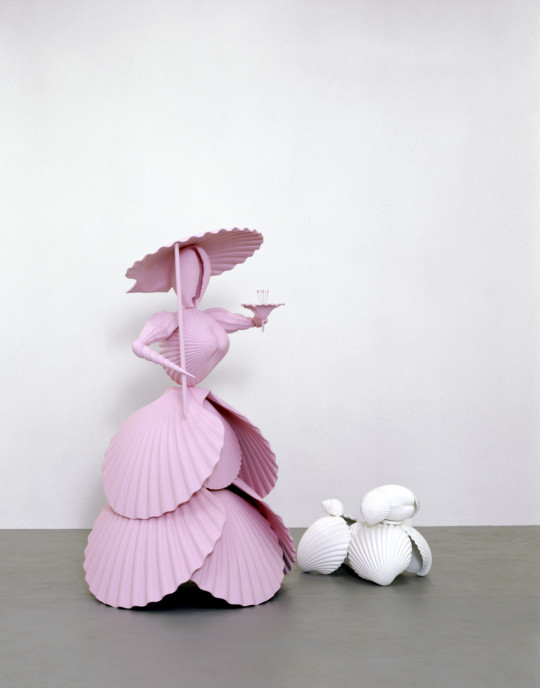
The sculpture is 1.75 m tall, and the woman and her dog are each monochromatic. Apart from the surprising scale, it is as if eccentric sculptures made of sea shells had been dipped into matt paint. This decision by Fritsch promotes the objects from kitsch into sculptural form. It is a kind of generalisation, which is appropriate to the (supraindividual) interpretation of the source objects as representatives of a particular kind of cultural production. Fritsch lists the materials of the sculpture as polyester, iron, and wood (along with paint). We're not informed about the authorship of the original piece (surely it exists?) but we can speculate that it was Victorian. By suppressing these personal details, Fritsch plays with the notion of the supraindividual tides of fashion and style, simultaneously foregrounding her own personal eye for form and adherence to the norms of contemporary sculpture.
0 notes
Text
Chaotic photograph session of the stuff I got from goodwill because my house has been taken over by giant boxes of bean bag stuffing, and it's too dark out to take photos outside. Why don't they just cut out the middle man, am I right?
Anyway, on to the things I bought:
First up, I've been looking for scarves to use as gift wrapping, and I liked this green dramatic flowery one.

I didn't know where else to photograph it, so I just threw it on the fridge. It went right into the cleaning pot anyway. My sister's birthday is Monday (I'm writing this on Saturday lol), so I have to get it cleaned and dried before then.
Another awkward shot, but this apron was really my style!

It's from Reprime, I guess, not a brand I'm familiar with. I've been looking for an apron either for painting or cooking, or both, and this one was $1.50, is one of my favorite colors, and has a cool zippered pocket as well as two open ones, so I kind of needed it.
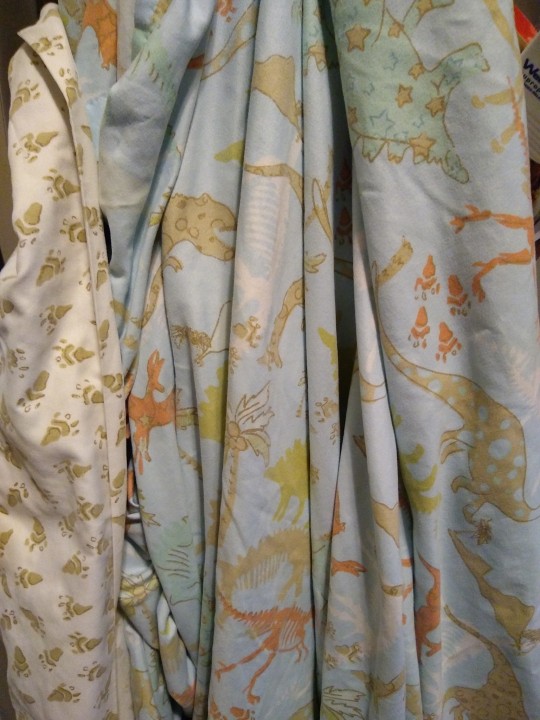
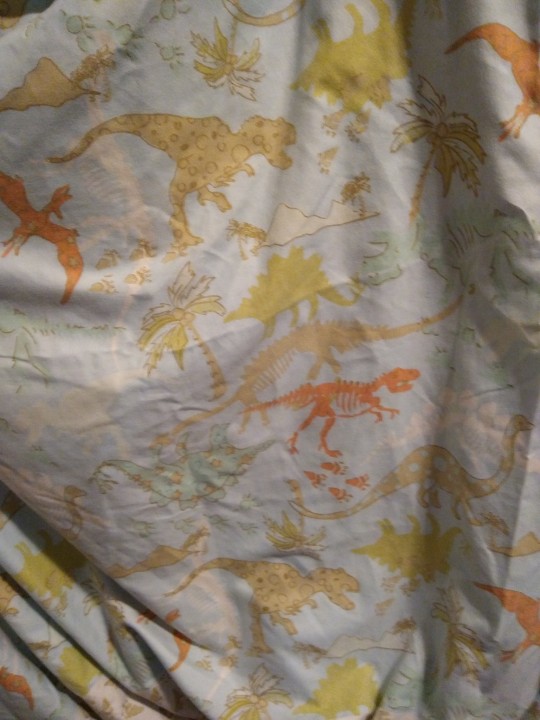
Ooo, bad photos. I found this sheet that's half white with dino prints and half blue with dinos (like, just straight up half-and-half, no border or anything). I really liked the look of the dinos, so I want to whip this into a skirt. It was also only $1.50, so even if that plan falls through, it can live in my stash for a while.
The next stuff is a group photo because of tumblr's dumb photo limit, but it's lotsa stuff.
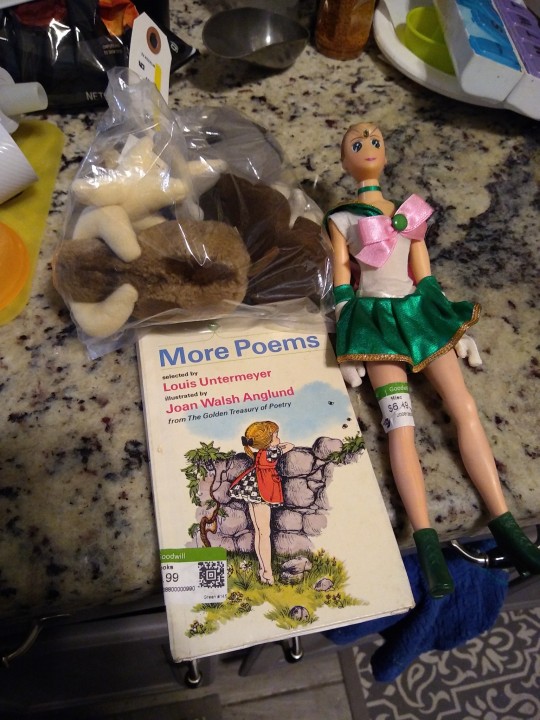
The Sailor Jupiter was a big surprise, I gotta say! I don't remember if I had Jupiter as a kid, but I did have some of the senshi, so a 90s Irwin Sailor Moon doll was really nostalgic to find.
Of course she's uhhh bald. The cashier saw her and went, "Wow, she's been through it," and I couldn't agree more. Her legs are a little sticky and stained, and the battery in her back was bad, so it's likely that her hair just fell out. I could reroot her, but I don't have hair on hand and I don't remember where my rerooting tool is, so she might get a wig instead. I haven't decided!
She was arguably overpriced at $6.50, but she did have her gloves, shoes, and necklace, and I wanted her, so she was my big splurge for the trip.

Ooh that shadow. My kitchen is a terrible place for photos ooh.
Jupiter having her Catwoman moment.
Anyway, I love little plushies, and I saw a bag full of McDonald's plush and pound purries (it's stylized as Pound Pur-r-ries on the tag, but everyone just writes purries so idk) and I had to bite. The McDonald's plush are 1997's Animal Pals, and I think we had the moose when I was a kid? Also the Internet says the bottom one is a brown bear, but I know a wombat when I see one.
Kinda funny that the plushies and Jupiter are both marked 1997. The plush are also in good condition, and they fit right in into my tiny plush collection!
The book was mostly a response to my constant impulse to buy vintage or antique books that cost a dollar. I also love poetry, but these poems are... let's just say not my style. I haven't finished the book, but my favorite so far is "Cat".

The twins have a bunch of toys, many of which make noise, and they love chasing their tails. The only thing is they aren't allowed out. They're indoor babies and also trapped in their baby house mostly.
And lastly, I have such a hard time resisting Halloween kitsch, so when I saw these adorably terrible hanging sign things, I just... I needed them.

They also glow in the dark!


I think I might put them in my window, and it's not lost on me that I passed on a trans flag but had to buy these. It's a compulsion.
Of course, I bought kind of a lot and spent kind of a lot of money, but things are really going on around here, and getting out of the house was a necessity. And I can't say no to things.
Also, interestingly, they've started a bag tax at goodwill! It's the first time I've seen that in Arizona; mostly cashiers are baffled when I pull out one of my dozen Halloween bags because I really don't like plastic bags. Bag taxes are pretty annoying, but it's good practice to use some sort of reusable bags. We've gotten a few from restaurants free with purchase, and libraries. The Halloween ones mostly from target, which used to have a whole bunch of cool stuff. Not anymore, though. Not anymore...
Ok bai!!
0 notes
Text
Review: Karen Jonas- The Rise and Fall of American Kitsch
There's a duality in Karen Jonas' The Rise and Fall of American Kitsch that keeps things interesting throughout. On the surface, much of the album is an upbeat celebration of America's obsession with kitsch, a Norman Rockwell portrait of a '50s household. But beneath that is a commentary on the same consumerism bred in that era and the late-stage Capitalism that it bred in today's society.
The inspiration for The Rise and Fall of American Kitsch was Jonas' viewing of Baz Luhrmann's 2022 biopic Elvis. Listening to the album, it's no surprise that the “King” of American kitsch, the subject of a million tacky velvet portraits, was a major influence. A rockabilly core runs through many of the album's twelve songs.
The album's best song is the humorous “Online Shopping.” With a doo-wop backing vocal and snap percussion, the song is an ode to an introvert's favorite thing, e-commerce. Jonas revels in her awkwardness in every word of “Online Shopping.” “I don't think I wanna leave my bathtub,” Jonas sings, “have you seen the crazy shit that happens?” Later she faces everyone's worst restaurant nightmare, “the waiter told me to enjoy my food / I looked right at him and said 'thanks, you too.' / Now I'm eating takeout in the nude.”
“Buy” is the album's shortest song and it’s most catchy. With a folksy acoustic guitar strum, Jonas details everything she sees in magazines and movies and finds herself inspired to buy. But the impulse to buy comes at a price, as her domestic life suffers from her daydreaming (“there's dishes on the counter / there's dishes in the bedroom”). A friend tries to get her into therapy for her problems but she decides instead to “buy a Lazy Boy to sleep away my day.”
There are some moments of pure unfiltered kitschy fun on The Rise and Fall of American Kitsch. “Plastic Pink Flamingos” is three and a half minutes of honky tonk ode to every trailer park's favorite lawn ornament. “Let's Go to Hawaii” channels not only Elvis in his movie period but also a major Jonas influence, Jimmy Buffett. With an island stroll, Jonas plays the part of a neglected vintage housewife trying to convince her workaholic husband to take an adults-only trip to Hawaii. “I'll wear a bikini,” she croons to her spouse, “let me pour you a drink.”
The spoken poem “American Kitsch” is Jonas' one shot at our societal need to buy that doesn't wrap itself in a veneer of positivity and vintage kitsch. It details the tendency to follow trends, piling more and more stuff up that is “forgotten, but not gone.” Later she says “Consumerism is our national religion” and it's hard to argue with her.
Elsewhere on The Rise and Fall of American Kitsch, Jonas goes full rockabilly on “Four Cadillacs,” tries on tinges of Southern gothic on “Shake Bump and Grind Show,” and explores the darker side of Elvis' story with the cautionary story of a pill mill on “Dr. Nick.” The album covers a lot of ground, dark and light, without ever losing its sense of humor.
1 note
·
View note
Text
There are actually lots of people who sell stuff successfully on here, usually drop ship stuff.
They’re just not disclosing it as ads, which they are supposed to do, and instead it's marketed in a very Tumblr-esque way which can be summed up as “omg guys look how CUTE this is” followed by a different account underneath going “omg found it!!” and it links to a drop ship site with the item(s).
And the link usually has an affiliate tracker in it, which you may or may not be able to spot unless you’re familiar with them, which is also something you are legally supposed to disclose.
I used to get a lot of offers from around 2016-2020 to sell “moon lamps” on here, y’know those orb lights that look like a moon? Yeah. I was offered a higher kickback to make it look like I wasnt posting an add because these sellers know Tumblrites don’t like ads.
They wanted it to look as organic and hyped up as possible and then I’d just so happen to be like “omg you guys it's on sale” and post a link. Which is skeevy as shit and also illegal af in the US.
It’s like the insta/tiktok girlies saying “link in bio” to get around saying “here’s a product I make money on if you buy it” because they want to sound like your friend because people are more likely to impulse buy stuff if a “friend” is recommending something.
They’re also trusting that everyone knows “link in bio” means “affiliate link” which is technically not enough of a disclosure but whatever.
This is why I tag all my own book promos with “affiliate links” because depending on which storefront you buy Hunger Pangs from, I may get a kickback from the vender which I do to help mediate the fees I lose from distribution. It’s not much—literal pennies in some cases—but I’m still legally required to state it.
It’s also why when I do post products I use or like, I make a point of letting people know I’m not an affiliate and not sponsored because despite the legal ramifications these people are flirting with by not disclosing their affiliate status, I want to be fully transparent with my followers when it comes to me trying to sell them things.
Y’all keep my lights on by reading my work and through my ko-fi and patreon. I am not about to risk that trust for the sake of some shitty vibrator sales from a sketch-ass drop shipper who wants me to pretend I’m not selling you things.
So, yeah. People do successfully sell stuff on here. A lot of us small indie creators sell our own work all the time.
But there are also drop-ship sellers on here who get enough of a kick-back from affiliate links to make selling cutesy kitsch stuff worth their time on here. They’re just making sure you don’t know you’re being marketed to.
It never fails to amuse me when I get “hello influencer” emails wanting me to push questionable products to my followers.
Like worstie, I can barely promote my own published book without wanting to curl up and die.
The fuck makes you think I’ll shill your discount wish shit?
21K notes
·
View notes
Text
"Funny and Festive: Discover the Hail Santa Pentagram Ugly Christmas Sweater"
The "Funny Ugly Christmas Sweater Hail Santa Pentagram" combines traditional holiday kitsch with irreverent humor and occult imagery, creating a provocative and attention-grabbing garment. This unconventional sweater subverts the typical cheerful Christmas themes by incorporating darker elements in a playful manner.

Buy now:19.95$
The centerpiece of the design likely features a pentagram, a five-pointed star often associated with occultism, cleverly integrated with Christmas motifs. Within or around the pentagram, the phrase "Hail Santa" appears, a cheeky play on words that sounds similar to a certain other phrase but refers to the jolly gift-giver instead.
The sweater might incorporate other humorous elements such as demonic-looking reindeer, elves with pointed ears and mischievous grins, or candy canes arranged to form pitchforks. Traditional Christmas colors of red and green could be paired with black for a more ominous feel.

Buy now
This type of sweater is designed for those with an edgy sense of humor who enjoy pushing boundaries and sparking conversations at holiday gatherings. It's perfect for ugly sweater contests, alternative Christmas parties, or for anyone who wants to inject a bit of subversive fun into the holiday season.
While definitely not suitable for all occasions, this sweater appeals to those who appreciate dark humor and enjoy playfully challenging conventional holiday norms. It's a statement piece that combines the ugly Christmas sweater tradition with a rebellious twist, sure to elicit laughs, raised eyebrows, and plenty of attention.
Small Christmas gifts are thoughtful tokens that capture the spirit of the season without overwhelming the recipient or breaking the bank. These compact presents are perfect for Secret Santa exchanges, stocking stuffers, or as additional treats alongside larger gifts.

Buy now
Popular small gift ideas include scented candles, artisanal chocolates, festive ornaments, or miniature bottles of premium spirits. Practical items like stylish keychain tools, pocket-sized hand creams, or travel-friendly tech accessories are both useful and appreciated.
For a personal touch, consider customized items such as monogrammed handkerchiefs, engraved keychains, or photo keepsakes. Book lovers might enjoy pocket-sized editions of classic novels or inspirational quote books.
Small gifts can also focus on experiences, like single-use face masks for a spa night, packets of gourmet hot chocolate, or seed packets for garden enthusiasts.

Buy now
The key to successful small gifts is choosing items that feel special and thoughtful, despite their size. These presents prove that good things often come in small packages.
#Funny Christmas sweaters#Ugly Christmas sweater#Hail Santa sweater#Pentagram Christmas sweater#Humorous holiday sweaters#Unique Christmas sweaters#Festive ugly sweaters#Christmas party attire#Small holiday gifts#Christmas stocking stuffers#Budget-friendly Christmas gifts#Tiny Christmas presents#Affordable holiday gifts#Cute Christmas gifts#Small gift ideas for Christmas#Festive mini gifts#View all AUTISM GIFTS products: https://zizzlez.com/trending-topics/hobbies/autism-spectrum-awareness-month/#All products of the store: https://zizzlez.com/
0 notes
Text
Citizen Kane
By Roger P. Smith
ESSAYS
—
DEC 3, 1984
Since the dawn of the sound era, an estimated 25,000 feature-length films have been produced—and that’s in the English language alone. When, in the early 1960s, an international group of film critics were polled as to their “number-one film of all time,” Citizen Kane was in first position. The repetition of this poll in the early 1970s and once again in 1982 produced the same result: Citizen Kane was a solid first each time. Even more important than the opinion of critics is the opinion of audiences. They too, decade after decade, have ranked Citizen Kane as their favorite film. For what truly sets Kane apart from every other film commonly called a “masterpiece” is that it’s also an enormous amount of fun.
If one thinks about it, the very idea that there could be unanimity of opinion on such a subject as “the best movie ever made” is absurd. Not only have different generations viewed movies differently, but groups within each filmgoing generation seek different things. Some search for an aesthetic experience; others look for social relevance; still others rank storytelling as the ultimate purpose of a film; and yet another group believes insight into human psychology is the special province of film. Citizen Kane’s accomplishment is, simply, that it achieves greatness whatever one’s perspective may be.
Despite the fact that Citizen Kane can’t truly be called “art”—or perhaps because of it—its greatness is undeniable. While some critics have gone so far as to call Kane kitsch, such people tend to regard estrangement from popular entertainment as proof of worth. In stylistic terms, the film is an amalgam of many forms of popular entertainment—the historic radio plays, the breakneck pace of vaudeville comedy, the cheap emotions of pulp fiction, the phony drama of the newsreel, the cartoon-like, larger-than-life quality of the characters. It is these “popular” qualities which underlie the film’s extraordinary claims on our attention.
While numerous individual elements of the film are truly artistic—cinematographer Gregg Toland’s deep-focus camera work leaps to mind—those elements are subservient to what was presumably Welles’ original purpose, and certainly his ultimate effect: to grab the audience from the very first frame and take it on a breathless rollercoaster ride through early twentieth-century America, leaving it at the end of the trip exhilarated and spent, but begging for more.
As for the social relevance of Citizen Kane, it—like the film’s art—is there when needed but always subjugated to the film as grand entertainment. At the time of Kane’s release, social commentators (particularly on the Left) felt the film failed to inveigh sufficiently against the abuse of wealth and power by such as Kane/Hearst. Instead, it tells the audience what it already believes: money doesn’t buy happiness. While the absence of a desire to transform human consciousness may bother some, for most of us Kane-as-Daddy Warbucks, lonely despite vast riches, is a far more engaging character than the malefactor of great wealth some would have him be.
It is in the telling of the story of Charles Foster Kane that the film transcends the limitations of popular entertainment and achieves greatness. That it does it through the devices of popular entertainment is irrelevant. From the first moment when the camera conspiratorially draws the viewer behind the giant iron gate with its “No Trespassing” sign, to the final moment when the sled is consumed by flames, every aspect of cinematographic art—photography, music, set design, editing, costuming, special effects—is assembled with a unifying vision into an endlessly fascinating portrait of a not-all-that-fascinating man.
The New York opening of Citizen Kane was at Broadway’s RKO Palace, newly converted from a vaudeville house, on May 1, 1941. While from the beginning the film’s extraordinary quality was recognized, it was not what today would be called a blockbuster. Its initial release earned RKO most, but not all, of its total cost—as Hearst-inspired fears of booking on the part of many exhibitors probably contributed to its failure to earn a profit. However, beginning in the 1950s, a series of releases brought the picture to the attention of a new generation of filmgoers. Most of them saw the film in grainy 16 mm prints in “art” houses. Despite all of the attention the film has subsequently received, few viewers have, according to Welles himself, seen the film as he intended it to be seen.
0 notes
Photo
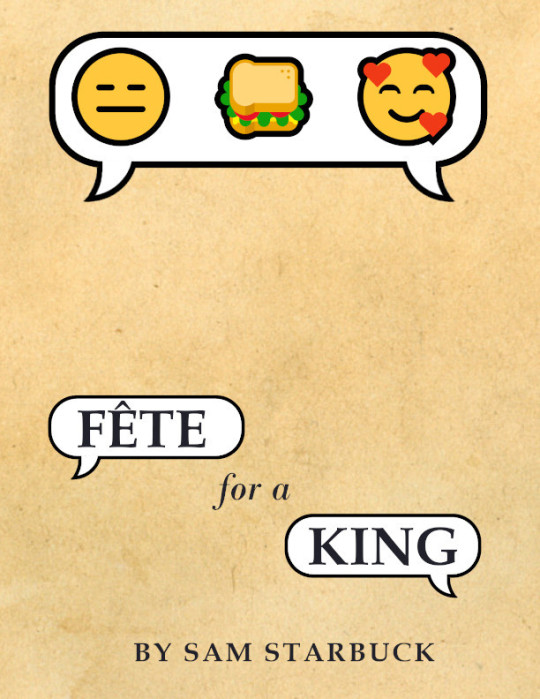
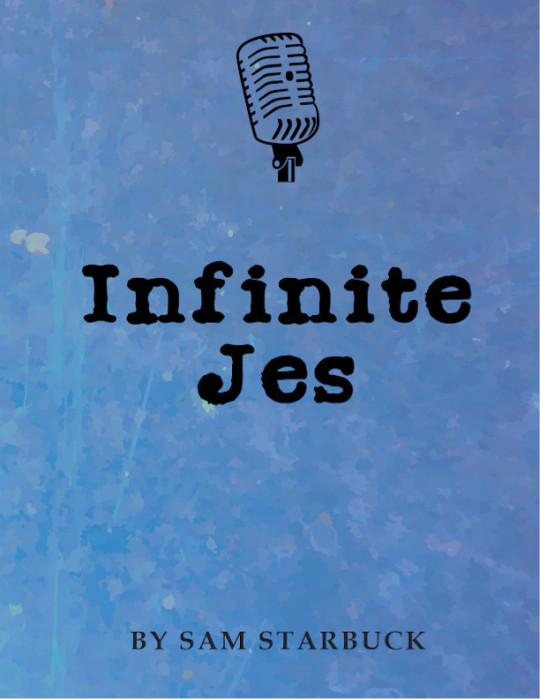
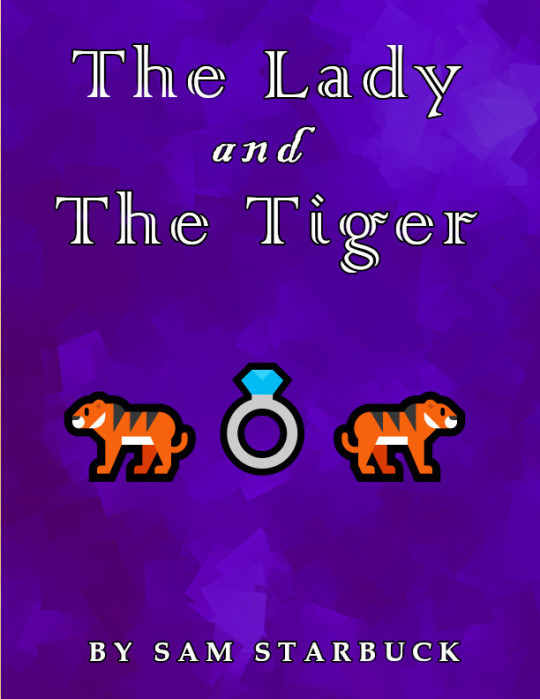
The third book in the Shivadh Romances, The Lady And The Tiger, is now available for purchase in print and epub!
Already familiar and just want to buy it?
The Lady And The Tiger: Hardcopy | Epub
As with the first two books in the series, The Lady And The Tiger is $3.99USD for epub, $12.99USD for print; prices vary a bit by currency for the hardcopy but are generally between 12 and 17 of your local smackers.
Want to learn more? Read on!
Welcome to Askazer-Shivadlakia, a coastal micronation with one of the few democratic monarchies in the world, Europe’s only Jewish royal family, and a distinctly queer-friendly culture. The irreverent but earnest Shivadh people have recently elected a new king, and there are changes afoot for the country.
The Lady And The Tiger, the third book in the Shivadh Romances series, finds King Gregory III’s cousin and assistant, Lady Alanna Daskaz, transported across the border to Galia, a nearby micronation that claims she’s the heir to their throne. Bringing her best friend Gerald, Duke of Shivadlakia, along with her, Alanna sets to work figuring out how to escape becoming Duchess of Galia without destroying Galia in the process. Jerry, who has a complicated life at the best of times, is trying to solve a few problems of his own along with helping Alanna solve hers. None of this is made easier by the fact that Alanna’s had a secret crush on Jerry since they were at school together, and Jerry’s just starting to believe he might be someone worthy of the Lady Alanna.
Purchase The Lady And The Tiger: Hardcopy | Epub
Download The Lady And The Tiger: Free PDF
If you’re new to the Shivadh Romances, the previous two books are available here:
Fete For A King introduces Crown Prince Gregory, who needs a caterer for his coronation and also could use a husband; it turns out he’s stuck with the American TV celebrity and kitsch connoisseur Eddie Rambler, who might want both jobs. Purchase Fete For A King: Hardcopy | Epub
Infinite Jes follows Gregory’s father Michaelis into retirement, and straight into the recording studio of nonbinary broadcast journalist Jes Deimos and Jes’s son Noah. Michaelis was just looking for a hobby; instead he might get a romance with Jes, as long as they can keep Noah out of trouble. Purchase Infinite Jes: Hardcopy | Epub
Download Fete For A King: Free PDF
Download Infinite Jes: Free PDF
394 notes
·
View notes
Text









South Street Seaport Style
It's gettin' fancy on Fulton street.
I needed therapy today; but instead I chose bubblegum pink '80s nostalgia and Mollie Ringwald kitsch.
Heyyy 👋
So here's the scoop on The South Street Seaport in terms of style:
Funny Face bakery is an Instagram paradise; there's enough lavender silk llame and bon lighting to make me look okay even after a sleepless night with two toddlers (well technically they aren't toddlers anymore but most of the night is crying and cuddling so they might as well be) on a futon twin mattress. And e'rything glows. Even the cookies ...even the Larry David cookie.
Mure and Grand is a pink and groovy boutique that is perhaps the cutest boutique I have ever walked into- I could not leave empty handed. The sparkle and sass in that shop are at max capacity and entering with any sort of feels might result in a kind of xanax-like effect. Feeling anxiety? Buy a crystal-studded yin yang signet surfer ring. Magically it's all zen✌️ feeling single forevah? Worried about the apocalypse? Ate too many sugar cookies with Drake's face on it? He used to call me on my cellphone...now I eat carbs... Buy yourself a tee that says you cried today. Then wear it with a pair of really good boots. Put on some Cyndi Lauper channel Mollie in a pair of fancy schmancy shades and just have fun🕶
17 notes
·
View notes